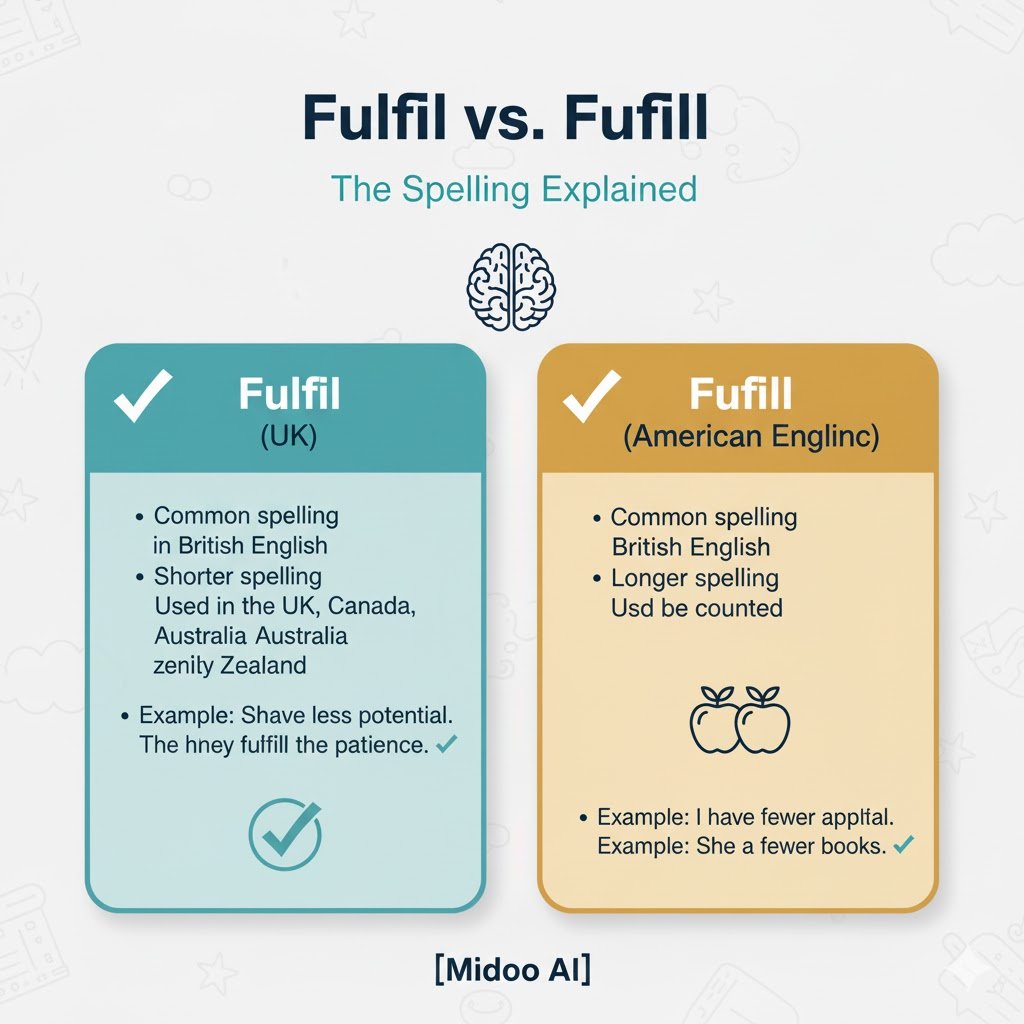Fulfil vs. Fulfill: What’s the Correct Spelling?

If you’ve ever typed fulfil and your spell checker corrected it to fulfill, you’re not alone. Many English learners—and even native speakers—wonder which spelling is correct.
At Midoo AI, our learners often ask: Is it fulfil or fulfill? The answer depends not on grammar, but on where your readers are. In this guide, we’ll clearly explain when to use each version, show real examples, and share memory tips so you’ll never get confused again.
1. The Basic Difference
The short answer:
- Fulfill → Preferred spelling in American English.
- Fulfil → Preferred spelling in British English.
Both words mean “to carry out,” “to satisfy,” or “to complete something.”
The meaning doesn’t change—only the spelling does.
Examples
✅ American English: “He worked hard to fulfill his dream.”
✅ British English: “She was happy to fulfil her promise.”
💡 Rule: The extra “l” in fulfill is typically American. British English usually keeps a single “l” before suffixes like -ed or -ing.
2. Fulfill in American English
In the U.S., fulfill is the standard spelling across all contexts—formal, academic, and casual.
Examples (U.S. English)
- “He wants to fulfill his potential as an artist.”
- “The company failed to fulfill its obligations.”
- “Volunteering helps me fulfill my sense of purpose.”
- “You need to fulfill all course requirements before graduation.”
Tip:
👉 If your audience is American or you’re writing for international business contexts, use fulfill.
3. Fulfil in British English
In the U.K., fulfil is the traditional and widely accepted spelling. You’ll see it in newspapers, official writing, and educational materials.
Examples (British English)
- “It was a lifelong ambition she finally fulfilled.”
- “The government must fulfil its campaign promises.”
- “He felt proud to fulfil his duty.”
- “Their new policy aims to fulfil environmental commitments.”
Even in British English, when adding suffixes like -ed or -ing, it doubles the l → fulfilled, fulfilling (same as in American English).
4. Quick Comparison Table
| Context | American English | British English |
|---|---|---|
| Base form | fulfill | fulfil |
| Past tense | fulfilled | fulfilled |
| Present participle | fulfilling | fulfilling |
| Meaning | To carry out, satisfy, complete | Same meaning |
5. Common Mistakes to Avoid
❌ “He wants to fulfil his potential.” (in American writing)
✅ “He wants to fulfill his potential.”
❌ “The company will fulfill its duties.” (in British writing)
✅ “The company will fulfil its duties.”
Tip from Midoo AI: Always consider your target audience’s region—that’s the key difference.
6. Easy Memory Tricks
- 🇺🇸 Fulfill → “Full” + “fill” → Two l’s, like in “U.S.” (two letters).
- 🇬🇧 Fulfil → British English likes simpler forms → one l in the base form.
- Both share the same forms when conjugated: fulfilled / fulfilling.
7. Real-Life Usage
- “Helping others can fulfill your life.” (U.S.)
- “They hope to fulfil their social responsibilities.” (U.K.)
- “He finally fulfilled his promise.” (Both)
- “We’re fulfilling all orders by the end of the month.” (Both)
✍️ Writing Tip from Midoo AI
When writing for international audiences—like websites, reports, or academic papers—consistency is key. Choose one style (U.S. or U.K.) and stick with it throughout your document.
Midoo AI automatically detects which version you’re using and ensures consistent spelling, punctuation, and phrasing across your text.
🧩 FAQS
Q1: Are both “fulfil” and “fulfill” correct?
Yes! Both are correct depending on the region. “Fulfill” is American English; “fulfil” is British English.
Q2: Do they have any difference in meaning?
No. Both mean “to carry out,” “to meet expectations,” or “to complete something.”
Q3: Which one should I use for international audiences?
If your writing targets global readers, fulfill (American spelling) is generally more widely recognized and accepted.
Q4: Is “fulfilled” spelled the same in both versions?
Yes. Both use fulfilled and fulfilling for their derived forms.
Q5: How can Midoo AI help me remember the difference?
Midoo AI detects your writing style preference (U.S. or U.K.) and provides automatic corrections, explanations, and examples—so you never mix them up again.